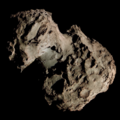 C/2019 U6 observed with an amateur telescope in June 2020 | |
| Orbital characteristics | |
|---|---|
| Observation arc | 1.54 yr |
| Aphelion | 960 AU (inbound) 604 AU (outbound) |
| Perihelion | 0.91427 AU |
| Last perihelion | 18 June 2020 |
| Next perihelion | ~10,500 yr (inbound) [1] ~5,200 yr (outbound) |
| Earth MOID | 0.0288 AU (4.31 million km; 11.2 LD) |
C/2019 U6 (Lemmon), or Comet Lemmon is a long period comet with a near-parabolic orbit discovered by the Mount Lemmon Survey on October 31, 2019. [2] It made its closest approach to the Sun on June 18, 2020. In June 2020 it was visible near the naked eye limit at an apparent magnitude of 6.0. [3] It is the 3rd brightest naked eye comet of 2020 after C/2020 F3 (NEOWISE) and C/2020 F8 (SWAN). It remained visible near the naked eye limit in June. [4]
This perihelion passage will decrease the comet's orbital period from about 10500 years to about 5200 years. [1]
Even though C/2019 U6 has an Earth-MOID of 0.0288 AU (4.31 million km ; 11.2 LD ), [2] the closest approach to Earth was on June 29, 2020 at a distance of 0.82 AU (123 million km ; 320 LD ).




